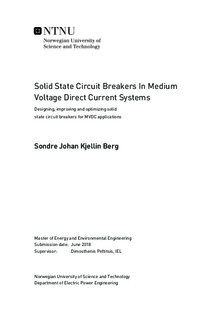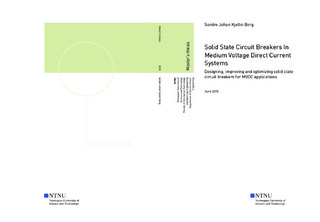| dc.description.abstract | In this text three different solid state circuit breakers (SSCB) for medium voltage direct current (MVDC) systems have been investigated, namely the interrupting, the current limiting and the resistive topologies. In particular, design strategies for each breaker topology has been proposed emphasizing the optimal design of passive elements with regard to different design goals. These design goals include the minimization of total breaking time, maximum fault current, ratings and required number of power semiconductor devices, size of passive components, on-state losses and transient response during no-fault conditions while at the same time maximizing the reliability and controllability of the system.
The breaker topologies designed using the proposed strategies have been simulated for a variety of cases to investigate different design trade-offs. The trade-offs found in the results shows how important it will be to design the breakers and optimize them according to the specific application to which it is to be used. Furthermore the improvement of important parameters with regard to applied power electronic devices have been investigated. How these improvements could potentially affect the performance of the breakers is an important result of the performed analysis' and simulations. The effects of external parameters such as the sensing and coordination equipment and strategies are also discussed and showed to be of great importance.
The findings of the literature study performed in context to this thesis will be shortly summarized in the theory part. These findings include topics on general MVDC systems, its applications and fault mechanisms as well as solid state circuit breakers found in literature. Relevant theory of power semiconductor devices and the modeling of RLC circuitry will also be included.
Analyzing and designing the different breaker topologies will be the main part of this text. The topologies are analyzed using state-space representation and design strategies are proposed for each topology. These design strategies also sheds light on different limitations regarding available technology.
To verify the proposed design strategies, a simulation of a simplified MVDC transmission system has been designed in Simulink. Using this system, all the topologies have been simulated using comparable parameters derived from commercially available technology.
The results of the simulations are compared and any peculiarities discussed. In particular the feasibility of the different topologies for different applications are discussed.
Specific suitability between topologies and applications are discussed as well as possible novel improvements of the topologies. A possible novel topology integrating the current limiting circuit breaker with a buck converter is proposed as a result of the the performed analysis. This however without further in-depth investigation of proposed topology. | |

